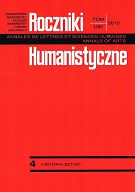Panegiryk pogrzebowy Marianny z Lubomirskich Sanguszkowej jako źródło do dziejów fundacji artystycznych w XVIII wieku
The Funeral Panegyric of Marianna Sanguszko (Lubomirska) as a Historical Source on the History of Artistic Foundations in the 18th Century
Author(s): Irena RolskaSubject(s): Cultural history
Published by: Towarzystwo Naukowe KUL & Katolicki Uniwersytet Lubelski Jana Pawła II
Keywords: Maria Sanguszko (Lubomirska); Paweł Karol Sanguszko; Falecki Hilarion of the Most Holy Sacrament; Lublin; Fathers Capuchins; Nowy Wiśnicz; Marianna Sanguszkowa; Falęcki Hilarion od Najświętszego Sakramentu; Lublin; kapucyni; Nowy Wiśnicz; karmelici
Summary/Abstract: Marianna Lubomirska (1693-1729), born of Teofila Zas³awska-Ostrogska and Józef Karol Lubomirski, remains virtually unrecognized as a historic figure. The vast patronage activities she undertook also await acknowledgement and research. The specialist literature in the history of art makes mention of magnificent ornaments and splendour accompanying her funeral. The decoration was designed for the Discalced Carmelites’ church in Nowy Wis´nicz by the Reformed Franciscan Father Mateusz Osiecki. The literature also refers to the coffin portrait of the Princess, created by Jan Aleksander Trycjusz and the catafalque made by Franciszek Kolisz of Kolbuszowa. A lot of details concerning Princess Marianna Sanguszko are provided by the panegyric that was dedicated to her by the Discalced Carmelite Father Falêcki Hilariusz of the Most Holy Sacrament from the New Wis´nicz monastery. Marianna and her husband, Paweł Sanguszko, founded a church for Fathers Capuchins in Lublin. This is where remains of her heart are kept. The princess’s patronage activities gave rise to a lot of other religious foundations.
Journal: Roczniki Humanistyczne
- Issue Year: 58/2010
- Issue No: 04
- Page Range: 161-169
- Page Count: 9
- Language: Polish

